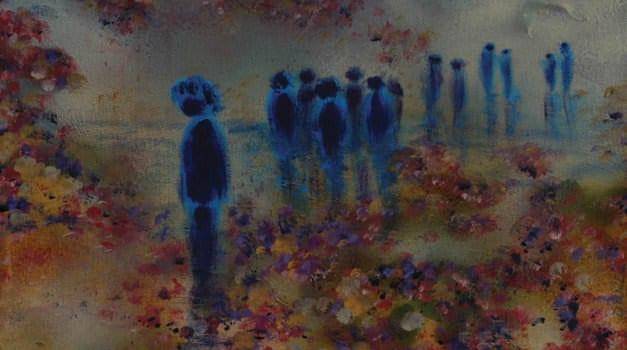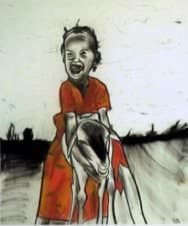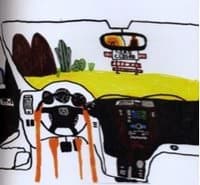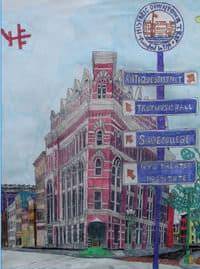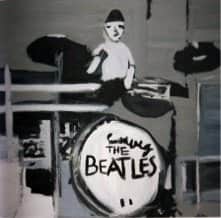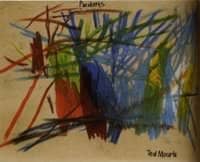Drawing Autism by Jill Mullin
 Instead of narrowing down and defining autism and the art created by those who live with the disorder, in Drawing Autism (Akashic, March), behavior analyst Jill Mullin embraces the full range and spectrum of autism and artistic expression. The rich and varied images she selects show the multiplicity of perspective, processes, media, themes and experiences of the artists, both young and old, offering a view of complexity, individuality, and ultimately a better understanding that good art, whether made by autistic artists or not, offers a unique yet universally accessible perspective and deeper understanding of how we are all connected.
Instead of narrowing down and defining autism and the art created by those who live with the disorder, in Drawing Autism (Akashic, March), behavior analyst Jill Mullin embraces the full range and spectrum of autism and artistic expression. The rich and varied images she selects show the multiplicity of perspective, processes, media, themes and experiences of the artists, both young and old, offering a view of complexity, individuality, and ultimately a better understanding that good art, whether made by autistic artists or not, offers a unique yet universally accessible perspective and deeper understanding of how we are all connected.
Some of the artists chosen for the book sell their work, are represented by galleries, and are professional artists. But others are hobbyists, children, art students, etc. Creating art in response to the disorder, as a form of therapy, as a hobby, as a means of expression when verbal expression is not an option, to convey a perspective they otherwise can’t, or simply for the enjoyment of it, the artists represented all come to creating via different paths. The degree to which autism affects their lives varies greatly, as does the work they produce. Beyond sharing a diagnosis, it is clear after reading and looking deeply that the artists embody the ability of visual arts to transcend differences and communicate something words cannot.
Mullin, however, did not simply put a book of nice pictures together. She also includes quotes from the artists about their process or work that offer yet another perspective and lens for seeing the art and understanding the artists and autism. There’s also an introduction by noted scientist and autism awareness spokesperson Dr. Temple Grandin. The text is refreshing for anyone used to reading pretentious artist statements that can sometimes create more distance between the artist, work, and viewer. Mullin’s simple questions for the artists are not necessarily the questions of museum panels and MFA critiques but in some ways they are more direct and honest and the manner in which they are answered throughout the book—sometimes with a single line of text, or an answer to a single question, others with paragraphs—gives the reader further insight into the work as well as a better understanding of how the artist sees the world.
Mullin asked each artist:
At what age did the act of creating art enter your life?
Why did you start creating art?
What inspires/excites you about creating art?
How do you choose your subjects? Why do you paint/draw what you do?
Do you think your art helps others understand how you view the world?
Some of the answers are very brief and some are given by people close to the artist. Whether brief or very detailed, the answers shed light on the person who created the work and owns that particular view of the world. After reading the quotes and looking again at the piece, a different understanding or perspective on the work is possible. Work that is incredibly detailed can be accompanied by one word answers or “I don’t know,” repeatedly. In other cases, there is clear artistic intention and an awareness of their own process and relation to art history.
Whether you know someone with autism or not, this book can help broaden your horizons on the wide spectrum of the disorder but also the power of visual expression to highlight the individual while somehow offering us something we can all relate to. Though not all of the images will appeal to everyone, the wide variety ensures that the book has something for everyone and the potential as a conversation starter.
Mullin divides the book into six sections, each with a theme that loosely connects the works in that chapter. Below are selections of one or two compelling works from each section of the book.
“Interaction, Individual, and Societal”
Many of the pieces in this section deal with ideas of isolation, frustration with interacting with the world or other people.
“Repetition, Repetition, Repetition”
This chapter features work that shows a repetitious or compulsive approach.
“Getting From Here to There”
Mullin says that during the submission and selection process it became clear how many artists were interested in transportation as a theme. The work and meaning can range to very literal to a more metaphorical sense of journey and watching the world go by.
“Bird’s-Eye View”
Focuses on landscapes that highlight an incredible level of detail that comes with hyper observation of one’s world, possibly giving us a glimpse into how these artists might see their world on a day-to-day basis.
“Another World”
This chapter includes work that depicts mythical or imaginary places as well as escape from the ordinary.
“It’s All History”
The work in this chapter is more literal and representative, based on artists’ interest in depicting the past or history.
“Art for Art’s Sake”
This chapter is a catch all for work that is not so theme-specific or perhaps less related to a specific disorder or trend on the autism spectrum. These pieces have a wider range of subject matter.
Image Credits:
Cover Image: Donna Williams, The Outsider (http://50watts.com/Drawing-Autism)
All other art from Drawing Autism
Buy this Book!
Amazon

